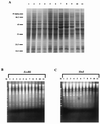Adhesin expression in matched nasopharyngeal and middle ear isolates of nontypeable Haemophilus influenzae from children with acute otitis media
- PMID: 9864255
- PMCID: PMC96336
- DOI: 10.1128/IAI.67.1.449-454.1999
Adhesin expression in matched nasopharyngeal and middle ear isolates of nontypeable Haemophilus influenzae from children with acute otitis media
Abstract
The HMW1 and HMW2 proteins, Hia, and hemagglutinating pili are important adherence factors in nontypeable Haemophilus influenzae. To gain insight into the relative importance of these adhesins in nasopharyngeal colonization and localized respiratory tract disease, we assessed their expression in matched nasopharyngeal and middle ear isolates of nontypeable H. influenzae from 17 children with acute otitis media. In all patients, including 11 with bilateral disease, the matched isolates were isogenic based on total protein profiles and genomic fingerprints. Of the nasopharyngeal isolates, 14 expressed only HMW1/HMW2-like proteins, 1 expressed only Hia, 1 expressed only pili, and 1 expressed both Hia and pili. Further analysis revealed concordance between nasopharyngeal isolates and the matched middle ear isolates for expression of the HMW1/HMW2-like proteins and Hia. In contrast, in the two children whose nasopharynges were colonized by piliated organisms, the corresponding middle ear isolates were nonpiliated and could not be enriched for piliation. Nevertheless, Southern analysis revealed that these two middle ear isolates contained all five hif genes required for pilus biogenesis and had no evidence of major genetic rearrangement. In summary, the vast majority of isolates of nontypeable H. influenzae associated with acute otitis media express HMW1/HMW2-like proteins, with expression present in both the nasopharynx and the middle ear. A smaller fraction of nasopharyngeal isolates express pili, while isogenic strains recovered from the middle ear are often refractory to enrichment for piliation. We speculate that the HMW adhesins and Hia are important at multiple steps in the pathogenesis of otitis media while pili contribute to early colonization and then become dispensable.
Figures


References
-
- Barenkamp S J, St. Geme J W., III Identification of a second family of high-molecular-weight adhesion proteins expressed by nontypeable Haemophilus influenzae. Mol Microbiol. 1996;19:1215–1223. - PubMed
-
- Brinton C C, Jr, Carter M J, Derber D B, Kar S, Kramarik J A, To A C, To S C, Wood S W. Design and development of pilus vaccines for Haemophilus influenzae diseases. Pediatr Infect Dis J. 1989;8:S54–S61. - PubMed
-
- Connor E M, Loeb M R. A hemadsorption method for detection of colonies of Haemophilus influenzae type b expressing fimbriae. J Infect Dis. 1983;148:855–860. - PubMed
Publication types
MeSH terms
Substances
Grants and funding
LinkOut - more resources
Full Text Sources
Other Literature Sources
Medical

